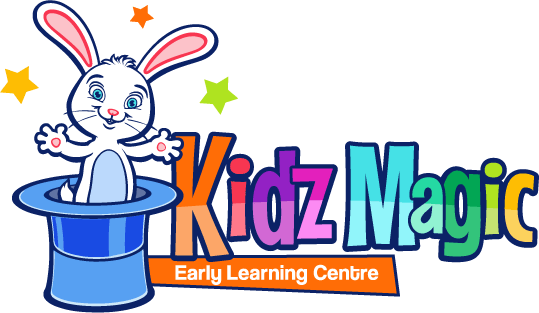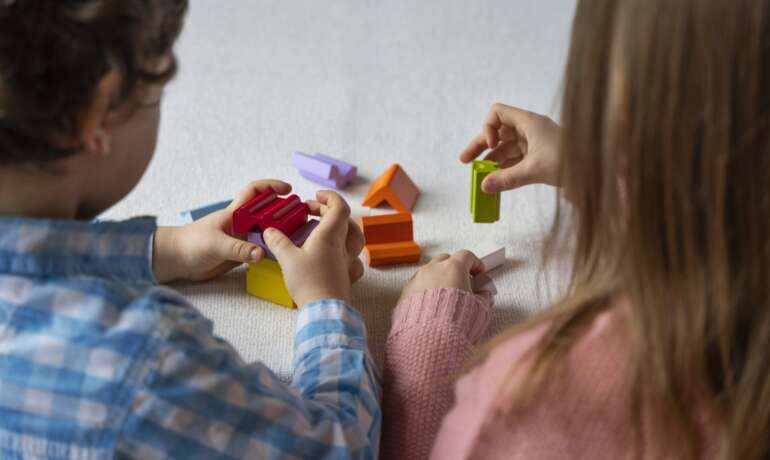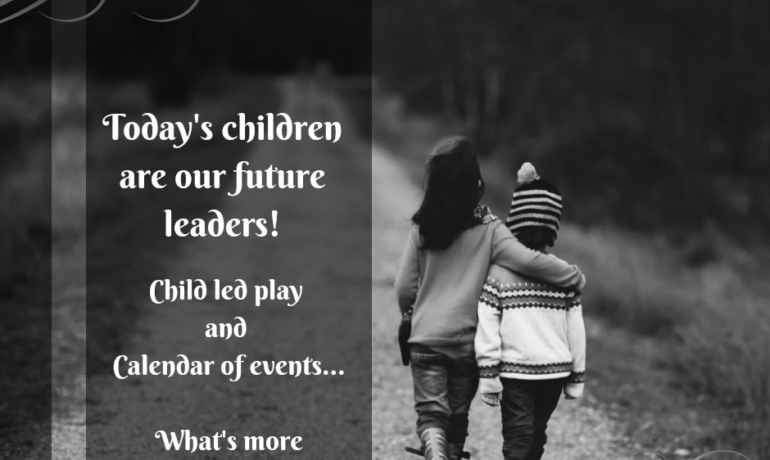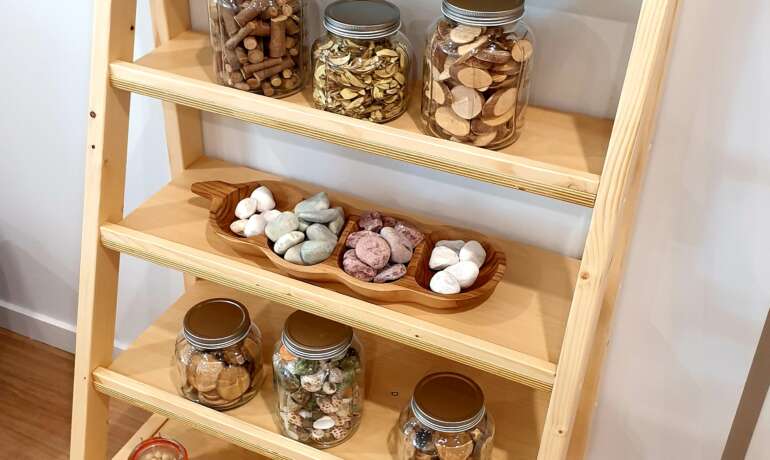What is the Curiosity Approach?
The Curiosity Approach is a modern early childhood education philosophy that encourages children to explore the world with confidence, creativity and independence. Rather than relying on plastic toys or rigid lesson plans, the approach focuses on real-life, open-ended resources that support meaningful discovery through imaginative play.
Developed by Stephanie Bennett and Lyndsey Hellyn in the UK, the approach draws on traditions from Montessori, Reggio Emilia, Steiner (Waldorf) and Te Whāriki, combining them into a flexible, child-focused model. It allows educators to adapt spaces to ensure environments suit each child’s unique rhythm and innate curiosity.
The Principles of the Curiosity Approach
The following Curiosity Approach principles guide educators and children in creating thoughtful, imaginative spaces:
Child-led learning
Educators follow children’s cues. Rather than directing children, programs are built around their own interests, encouraging independence and exploration. When children are trusted to take the lead, they learn at their own pace and feel more invested in their own learning and progress.
Calm, homely environments
Curiosity classrooms are designed to feel like an extension of home, avoiding overstimulation. Instead, children are surrounded by neutral tones, natural light and familiar textures that support calm thinking. These tranquil environments foster a strong sense of belonging.
Sustainability
Natural materials, recycled items and real-world objects are utilised to reduce waste and foster respect for the environment. From shells and fabric to vintage teapots and wooden tools, these resources also support open-ended and sensory-rich learning. Sustainability becomes part of everyday learning.
Mindful teaching
Educators act as observers and co-learners, stepping back to allow children to explore, ask questions, and figure things out for themselves. This supports critical thinking, problem-solving skills, and independent thinking. The learning environment itself is viewed as a “third teacher”, where every material and space is designed with intention to inspire a child’s natural awe, encourage collaboration and support individual learning journeys.
Life skills and emotional growth
Through real-world play and daily routines, children learn to manage emotions, take responsibility, and build resilience. The approach helps in preparing children for both school and life by supporting emotional regulation, confidence, and creating active learners.

Why the Curiosity Approach Matters in Early Childhood Settings
In today’s fast-paced world, children leading busy lives benefit from slowing down and being given space to follow their own development. The importance of the Curiosity Approach lies in its focus on meaningful experiences, not just outcomes.
Educators at Kidz Magic have seen firsthand the Curiosity Approach benefits. When children are given time and trust, they engage more deeply, show enhanced confidence, and take initiative in their own learning. Seeing their ideas and artwork displayed throughout the room, also helps reiterate that their voice matters.
“We’ve noticed that children are more engaged when the learning environment reflects their ideas, artwork, and input. They feel a sense of ownership, and that leads to a stronger connection to their space and peers.”
– Hayley Le, Centre Manager at Kidz Magic Capestone
This approach aims to create children who feel confident in making their own choices. By valuing a child’s natural curiosity and self-expression, it shifts them away from being passive learners into becoming active, lifelong learners.
The Curiosity Approach in Early Childhood (EYLF)
The Curiosity Approach in early childhood education aligns naturally with the Early Years Learning Framework (EYLF V2.0), which emphasises belonging, being, and becoming.
By using authentic resources and real-life objects, educators support all domains of development:
- Communication: Children are encouraged to express their thinking, stories, and ideas through role play and collaborative exploration.
- Physical development: Fine and gross motor skills are strengthened through manipulating loose parts and open-ended setups. Outdoor play is also prioritised.
- Social and emotional growth: Trust-based relationships are nurtured through calm routines and shared discoveries.
This connection between the Curiosity Approach EYFS, early years education, and the learning process supports children to grow into confident, capable, and reflective learners.
How Kidz Magic Uses the Curiosity Approach
At Kidz Magic, the Curiosity Approach is embedded in rooms across both our Capestone and Edens Crossing centres. Our daily rhythms are designed to be flexible and responsive, allowing us to follow each child’s lead.
Our educators intentionally design the learning environment to reflect the children’s voices, interests and curiosities. Children at these centres have been involved in:
- Exploring real-world objects such as old phones, household items and fabrics.
- Playing shopkeeper, where children design their own shops using recycled and natural elements.
- Participating in daily rituals that support independence and decision-making. This includes progressive meals, creating calmer transitions and providing children the time to listen to their bodies.
- Creating centre assets such including acknowledgements of country, and designing and writing their own centre booklet using their drawings, stories and layout ideas. By seeing their contributions proudly displayed throughout the centre, children gain the confidence to share their own ideas, experiment with new ones, and recognise that their voice matters in shaping the learning environment.

A Day in the Life – Real Examples from Our Classrooms
To understand the Curiosity Approach examples in action, picture a morning in one of our kindy rooms.
Children arrive to find a table set with wooden scales, dried flowers, stones and spice jars. They begin playing shop, assigning roles, setting up prices and exchanging items. As they do, they use all their senses. They feel textures, smell herbs and communicate with their peers.
In another corner, a group gathers around the art space where natural brushes, fabric scraps and clay are available. Without any adult instruction, they begin to experiment, discovering how fabric soaks up paint or how pressing a leaf into clay leaves behind a detailed print.
Across the centre, our youngest children are exploring treasure baskets filled with natural materials such as sand, pinecones, dried citrus, flowers and leaves. Using spoons, cups and bowls, they scoop, pour and manipulate the items, developing fine motor skills as well as an early understanding of weight, volume and cause-and-effect.
These kinds of Curiosity Approach settings nurture a child’s imagination, creativity and self-expression. There is no single way to play. Children are free to create their own games and follow their own ideas.
The Role of the Educator
Curiosity Approach teaching is subtle, intentional and reflective. Educators observe closely, listen deeply and support children in developing their own ideas rather than directing play.
Instead of stepping in with answers, they ask open-ended, reflective questions.
- “What do you think would happen if we added more leaves?”
- “What do you think we should do next?”
- “How could we make it stand up taller?”
This gentle guidance encourages children to take risks, build persistence and figure things out for themselves. Even when no specific task is assigned, children learn through trial and error, discussion and self-motivation.
Following these moments of guidance, our educators engage in reflective practice, where they critically reflect on the interaction, and explore ways to further enhance children’s experiences.
Both our Capestone and Eden’s Crossing centres have been receiving mentorship by Alisa from AJ Training, whose support has helped embed the Curiosity Approach more deeply into their practice. Through her coaching, the team has strengthened their confidence in designing environments, documenting learning and delivering child-led, curiosity-driven programs.
Involving Families in the Curiosity Approach
Families play a valuable role in supporting the Curiosity Approach at home. Many of the same principles apply.
- Use household items for open-ended resources. Bowls, pegs or cardboard boxes
- Let children lead the way in games and routines
- Encourage questions and allow for quiet moments of observation
At our centres, families are invited to contribute natural or recycled materials. Items like corks, seed pods, baskets or timber offcuts help us build meaningful provocations. Parents are also welcome to observe a classroom implementing the approach and see the learning in action.
Nurturing Future Leaders with the Curiosity Approach
The Curiosity Approach childcare philosophy is helping us nurture confident learners who are creative, compassionate and grounded in their sense of self. By honouring a child’s natural curiosity, we are building a foundation for learning that lasts well beyond the early years.
We would love to welcome you into our centres to see the difference for yourself. Contact your local Kidz Magic centre to learn more or book a tour.
Australian Children’s Education & Care Quality Authority (ACECQA) 2023, Belonging, Being & Becoming: The Early Years Learning Framework for Australia V2.0, ACECQA, Sydney.
Bennett, S & Hellyn, L 2017, The Curiosity Approach: Our World of Wonder, Awe and Curiosity, The Curiosity Approach, Coventry.
Department of Education (Australian Government) 2023, Early Childhood Education and Care Reform Agenda, Department of Education, Canberra.
Edwards, C, Gandini, L & Forman, G (eds.) 2012, The Hundred Languages of Children: The Reggio Emilia Experience in Transformation, Praeger, Santa Barbara.
Montessori, M 2004, The Montessori Method, Rowman & Littlefield, Lanham.
Steiner, R 1995, The Education of the Child, Anthroposophic Press, New York.




